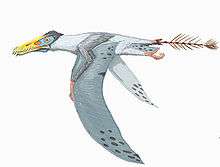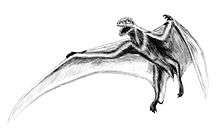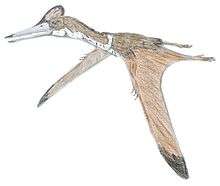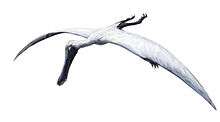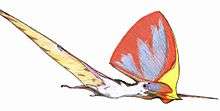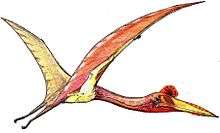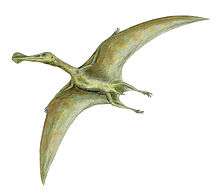Dimorphodontia
Dimorphodontia is a group of early "rhamphorhynchoid" pterosaurs named after Dimorphodon, that lived in the Late Triassic to Early Jurassic.
| Dimorphodontians | |
|---|---|
 | |
| Skeletal reconstruction of Dimorphodon macronyx, Rocky Mountain Dinosaur Resource Center | |
| Scientific classification | |
| Kingdom: | Animalia |
| Phylum: | Chordata |
| Order: | †Pterosauria |
| Clade: | †Macronychoptera |
| Clade: | †Dimorphodontia Seeley, 1870 |
| Genera | |
A family, Dimorphodontidae, was named in 1870 by Harry Govier Seeley (as "Dimorphodontae") with Dimorphodon as the only known member.[1] In 2003 David Unwin defined a clade Dimorphodontidae, as the group consisting of the last common ancestor of Dimorphodon macronyx and Peteinosaurus zambellii, and all its descendants.[2] However, later studies found that Dimorphodon may not be closely related to Peteinosaurus, so this definition of Dimorphodontidae would therefore be superfluous. In 2014, Brian Andres and colleagues defined another clade, Dimorphodontia, as a replacement. Dimorphodontia would include all pterosaurs more closely related to Dimorphodon than to Pterodactylus. According to the analysis published by Andres et al., Dimorphodontia is also a small group, including only Dimorphodon and Parapsicephalus.[3]
In 2018, a close relative of Dimorphodon was described from the Late Triassic of North America by Britt and colleagues, and was named Caelestiventus. This discovery expanded the geographic, temporal and also the ecological range of dimorphodontians, as it was discovered in the Late Triassic Nugget Sandstone in Utah, which was a desert at the time. Britt and colleagues also redefined Dimorphodontidae as the least inclusive clade containing Dimorphodon macronyx and Caelestiventus hanseni.[4]
References
- Seeley, H.G. 1870. "Remarks on Prof. Owen's Monograph on Dimorphodon". Annals and Magazine of Natural History, Series 4, 6: 129.
- Unwin, D. M. 2003. "On the phylogeny and evolutionary history of pterosaurs". In: Buffetaut, E. & Mazin, J.-M. (eds), Evolution and Palaeobiology of Pterosaurs. Geological Society, London, Special Publications 217: 139-190
- Andres, B.; Clark, J.; Xu, X. (2014). "The Earliest Pterodactyloid and the Origin of the Group". Current Biology. 24 (9): 1011–6. doi:10.1016/j.cub.2014.03.030. PMID 24768054.
- Britt, Brooks B.; Dalla Vecchia, Fabio M.; Chure, Daniel J.; Engelmann, George F.; Whiting, Michael F.; Scheetz, Rodney D. (2018-08-13). "Caelestiventus hanseni gen. et sp. nov. extends the desert-dwelling pterosaur record back 65 million years". Nature Ecology & Evolution. 2 (9): 1386–1392. doi:10.1038/s41559-018-0627-y. ISSN 2397-334X. PMID 30104753.

